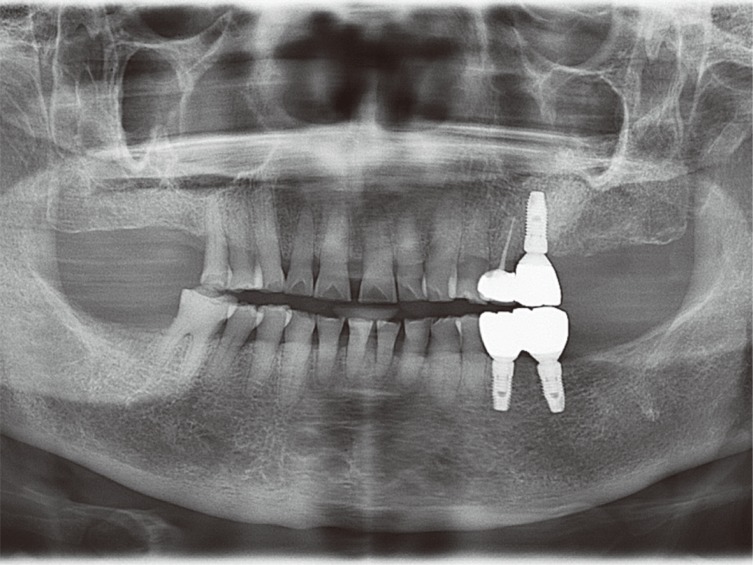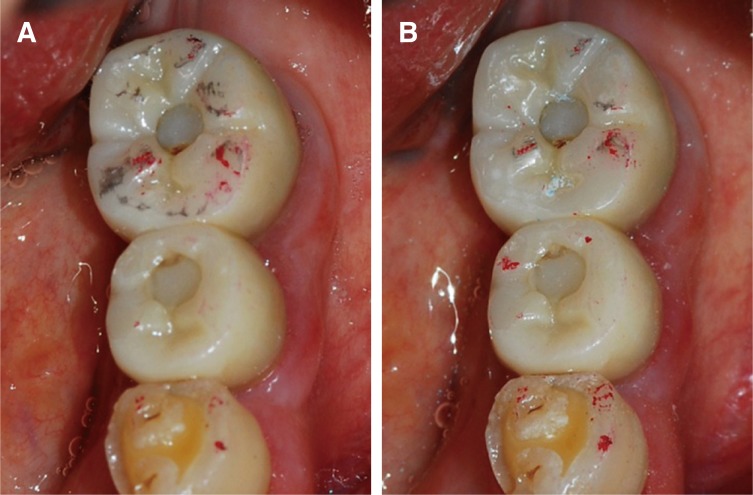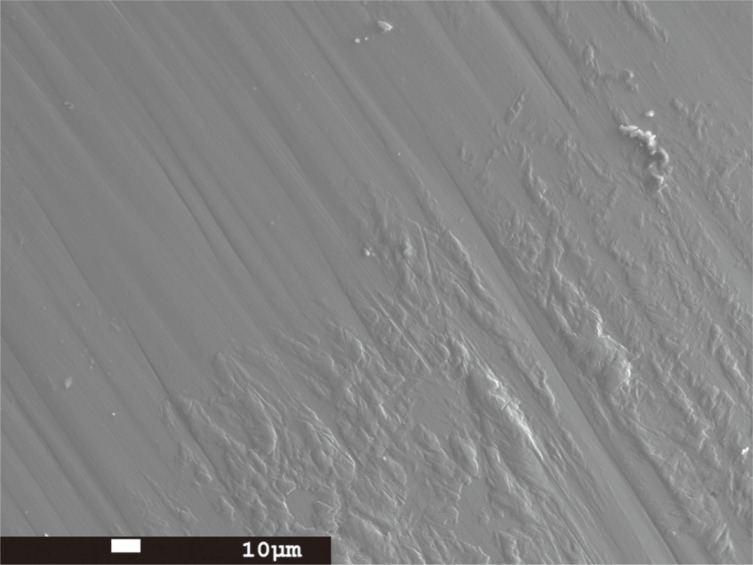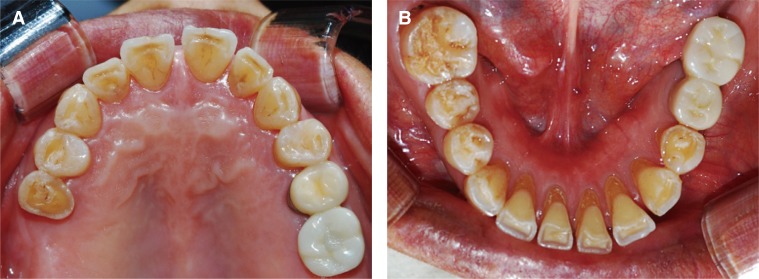J Adv Prosthodont.
2017 Apr;9(2):138-142. 10.4047/jap.2017.9.2.138.
Metal stain on monolithic zirconia restoration: A case report
- Affiliations
-
- 1Department of Dentistry, Gangneung Asan Hospital, University of Ulsan College of Medicine, Gangneung, Republic of Korea.
- 2Department of Prosthodontics and Research Institute of Oral Science, College of Dentistry, Gangneung-Wonju National University, Gangneung, Republic of Korea. doctorcj@gwnu.ac.kr
- KMID: 2376302
- DOI: http://doi.org/10.4047/jap.2017.9.2.138
Abstract
- In restorative treatment using fixed dental prostheses, dentists should select appropriate restoration material among various types of dental materials. The strength, marginal fit, esthetics, wear resistance, biocompatibility, and cost are important factors in the choice of restoration materials. The present case showed a surface stain on a monolithic zirconia restoration that was due to wear between the monolithic zirconia restoration and the base metal alloy restoration. This phenomenon was confirmed by surface roughness measurement and electron probe micro-analysis.
Keyword
MeSH Terms
Figure
Reference
-
1. Guess PC, Att W, Strub JR. Zirconia in fixed implant prosthodontics. Clin Implant Dent Relat Res. 2012; 14:633–645. PMID: 21176095.
Article2. Carames J, Tovar Suinaga L, Yu YC, Pérez A, Kang M. Clinical Advantages and Limitations of Monolithic Zirconia Restorations Full Arch Implant Supported Reconstruction: Case Series. Int J Dent. 2015; 2015:392496. PMID: 26124835.
Article3. Sailer I, Fehér A, Filser F, Gauckler LJ, Lüthy H, Hämmerle CH. Five-year clinical results of zirconia frameworks for posterior fixed partial dentures. Int J Prosthodont. 2007; 20:383–388. PMID: 17695869.4. Jiang L, Liao Y, Wan Q, Li W. Effects of sintering temperature and particle size on the translucency of zirconium dioxide dental ceramic. J Mater Sci Mater Med. 2011; 22:2429–2435. PMID: 21922331.
Article5. Wataha JC. Alloys for prosthodontic restorations. J Prosthet Dent. 2002; 87:351–363. PMID: 12011845.
Article6. Amer R, Kürklü D, Kateeb E, Seghi RR. Three-body wear potential of dental yttrium-stabilized zirconia ceramic after grinding, polishing, and glazing treatments. J Prosthet Dent. 2014; 112:1151–1155. PMID: 24836531.
Article7. Burgess JO, Janyavula S, Lawson NC, Lucas TJ, Cakir D. Enamel wear opposing polished and aged zirconia. Oper Dent. 2014; 39:189–194. PMID: 23848069.
Article8. Kim MJ, Oh SH, Kim JH, Ju SW, Seo DG, Jun SH, Ahn JS, Ryu JJ. Wear evaluation of the human enamel opposing different Y-TZP dental ceramics and other porcelains. J Dent. 2012; 40:979–988. PMID: 22892464.
Article9. Lawson NC, Janyavula S, Syklawer S, McLaren EA, Burgess JO. Wear of enamel opposing zirconia and lithium disilicate after adjustment, polishing and glazing. J Dent. 2014; 42:1586–1591. PMID: 25257823.
Article10. Stober T, Bermejo JL, Schwindling FS, Schmitter M. Clinical assessment of enamel wear caused by monolithic zirconia crowns. J Oral Rehabil. 2016; 43:621–629. PMID: 27198539.
Article11. Mundhe K, Jain V, Pruthi G, Shah N. Clinical study to evaluate the wear of natural enamel antagonist to zirconia and metal ceramic crowns. J Prosthet Dent. 2015; 114:358–363. PMID: 25985742.
Article12. Huh YH, Park CJ, Cho LR. Evaluation of various polishing systems and the phase transformation of monolithic zirconia. J Prosthet Dent. 2016; 116:440–449. PMID: 27061631.
Article13. Preis V, Weiser F, Handel G, Rosentritt M. Wear performance of monolithic dental ceramics with different surface treatments. Quintessence Int. 2013; 44:393–405.14. Kontos L, Schille C, Schweizer E, Geis-Gerstorfer J. Influence of surface treatment on the wear of solid zirconia. Acta Odontol Scand. 2013; 71:482–487. PMID: 23638857.
Article15. Saiki O, Koizumi H, Nogawa H, Hiraba H, Akazawa N, Matsumura H. Influence of ceramic surface texture on the wear of gold alloy and heat-pressed ceramics. Dent Mater J. 2014; 33:865–873. PMID: 25483387.
Article16. Bollen CM, Lambrechts P, Quirynen M. Comparison of surface roughness of oral hard materials to the threshold surface roughness for bacterial plaque retention: a review of the literature. Dent Mater. 1997; 13:258–269. PMID: 11696906.17. Kanbara T, Sekine H, Homma S, Yajima Y, Yoshinari M. Wear behavior between zirconia and titanium as an antagonist on fixed dental prostheses. Biomed Mater. 2014; 9:025005. PMID: 24495945.
Article18. Koran A, Craig RG, Tillitson EW. Coefficient of friction of prosthetic tooth materials. J Prosthet Dent. 1972; 27:269–274. PMID: 4501138.
Article
- Full Text Links
- Actions
-
Cited
- CITED
-
- Close
- Share
- Similar articles
-
- Esthetic anterior restoration using 3M Lavaâ„¢ Esthetic monolithic zirconia
- Full mouth rehabilitation using monolithic zirconia: a clinical report
- Fracture strength of zirconia monolithic crowns and metal-ceramic crowns after cyclic loading and thermocycling
- Superimposition: a simple method to minimize occlusal adjustment of monolithic restoration
- Maxillary cement retained implant supported monolithic zirconia prosthesis in a full mouth rehabilitation: a clinical report







